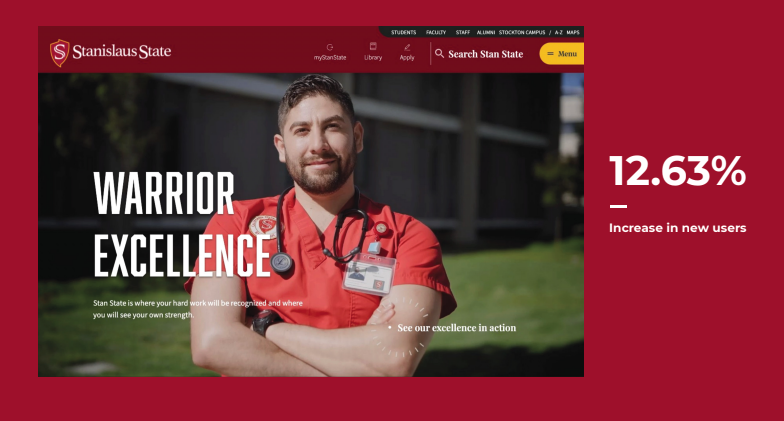Measuring Impact: How to Prove the Value of Your Higher Ed Digital Strategy
Authored by: Bjorn Thomson and Richard Nosek.
It’s not easy being a higher ed leader in 2024. As demographics shift, colleges and universities continue to compete for an ever-shrinking pool of prospective students. At the same time, students and their families are asking hard-hitting questions about whether or not obtaining a college degree is worth the cost. And as a result, it’s harder than ever to reach the enrollment targets that keep your institution financially viable.
Is your digital strategy helping your institution meet these high-stakes challenges head-on?
As a marketing leader, you may not be directly responsible for hitting enrollment goals. But as the steward and champion of your school’s brand and story, you play an incredibly important supporting role in moving the needle — and in furthering all of your institution’s business objectives.
Cash-strapped institutions are cutting budgets and scrutinizing ROI now more than ever. So if you haven’t already, you’ll undoubtedly need to demonstrate that keeping — or even increasing — your marketing spend is worth the investment.
Here’s what to do to get started.
Define What Digital Marketing Success Looks Like
Most institutions set short and long-term enrollment goals. At a high level, your President and Board of Trustees would likely think about your institution’s overarching success in terms of whether or not your school reaches those targets.
But if your Admissions team recruits a smaller incoming class than expected — or if summer melt and/or current student attrition rates increase — does that automatically mean your website strategy is ineffective? Of course not. Your digital strategy fuels the top of the funnel. Responsibility for bottom-of-the-funnel decisions and retention rates lies elsewhere.
To that end, your marketing team’s definition of success should primarily focus on the areas where you make (or want to make) the most impact.
For results-focused marketing teams, success might look like:
- Establishing a regular pattern of website analysis and optimization
- Creating an inclusive, student-focused content strategy that tells a compelling story
- Increasing brand awareness in organic and social channels
- Setting a new record for “Apply Now” conversions
- Streamlining marketing workflows and eliminating manual tasks
- Offering a highly personalized, tailored user experience
- Learning how to leverage AI to improve efficiency
- Increasing engagement with an underperforming target market
- Enabling student self-service options that remove friction from the UX
All of these success markers support your institution’s enrollment goals. But they’re tailored specifically to your digital marketing strategy and to the things your team can directly influence.
Learn how Ashland University incorporated storytelling into their content strategy.
Establish Website-Specific SMART Goals
The key to turning your ideas into reality is to clarify your team’s success markers as explained above. Then establish appropriate goals and metrics that ladder up to each one.
We recommend setting SMART goals that are:
- Specific
- Measurable
- Achievable
- Relevant
- Time-bound
For example, if one of your success markers is to achieve a record number of “Apply Now” conversions, establishing accompanying SMART goals might look like this:
- Gather historical data to establish appropriate benchmarks and targets by June 30, 2024
- Identify student personas and define their user needs by December 31, 2024
- Optimize key pages of your current higher ed website to incorporate action-focused design principles by March 31, 2025
- Create clear user pathways that lead students deeper into the decision funnel by June 30, 2025
- Increase traffic to your admissions landing page by 25% year over year beginning in 2025
Or perhaps you want to increase brand awareness. You’d need to follow the same process as outlined above and:
- Define what you mean by brand awareness and set clear parameters of what success looks like
- Establish historical benchmarks to measure past and current brand awareness
- Lay out the strategies you’ll implement and the timeline for each
You’ll notice we included hypothetical deadlines for each SMART goal. That’s because true SMART goals are time-bound. Of course, only you can determine what’s realistic for your institution in terms of timing. It’s wise and prudent to take a long view when starting down this path. Working with an agency partner can augment your internal team’s capabilities and speed up your progress.

Zero in on the Metrics That Matter Most
Many marketers operate in one of two extremes. They’re drowning in data and don’t know how to make heads or tails of it. Or they don’t look at data at all.
Your goal should be to land somewhere in the middle.
It’s better to choose a few metrics that align with your SMART goals and faithfully track them than become paralyzed by an all-or-nothing mindset. The right data can give you a window into your users’ experience and help you identify opportunities for optimization.
For example, if one of your SMART goals is to increase the number of people who click on the “Apply Now” button, you’d want to track things like:
- Page views, session duration, and bounce rates — especially for the parts of the user journey that are specifically designed to lead students to the Apply Now button. If you see week-over-week dips in performance, that’s a sign something’s wrong.
- Where visitors who’ve previously converted on the Apply Now button came from. Did they come from organic search? Paid media ads? Referral sites? Identifying patterns helps you target more of your marketing efforts in fruitful areas.
- The pieces of content converters interacted with most. Did they watch a video? Check out a student testimonial? Search for a particular major, minor, or extracurricular program? Knowing what’s resonating with students (and other audience segments) will help you cull what’s ineffective and replace it with highly customized content gold.
- Conversion rates for desired actions such as requesting information, registering for open houses and other events, or booking a consultation with an Admissions Counselor. All of these actions are important markers along the path to conversion.
You can also leverage UTM parameters to gather data about the performance of specific campaigns to drive applications — even if the final conversion steps take place on a third-party application site and the Admissions team tracks official enrollment numbers.
Test, Measure, Optimize, Repeat
Everyone talks about making data-driven marketing decisions. But at most colleges and universities, marketing teams operate separately from the departments they support. As a result, many don’t have visibility into all the numbers their marketing strategies are expected to influence.
That can feel like an insurmountable obstacle. But the truth is, by creating specific, measurable goals and drilling down into the right metrics, you can successfully demonstrate the value of your digital marketing strategy.
The secret is to embrace a spirit of continuous experimentation and improvement. Some of the strategies you’ll try won’t work. And you may not reach every SMART goal you set.
That’s ok. Don’t be afraid to test your assumptions and track the results. Optimize what works and pivot away from what doesn’t. There’s power in knowing where you stand and boldly taking action to move your institution forward. Soon, the results will follow.
And remember: You don’t have to go it alone. We’d love to help.


